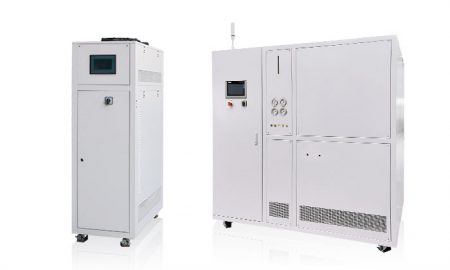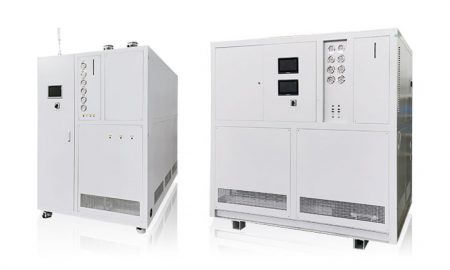Thermal Management of Electric Vehicle Battery Systems
完璧な温度制御ソリューションについては、今すぐお問い合わせください。
Types of thermal management of electric vehicle battery systems
Current thermal management solutions can be roughly divided into four types: air cooling, liquid cooling, direct cooling, and phase change materials.
1. Air cooling is a common and simple method of heat dissipation, using natural airflow or fans to blow away the heat absorbed by the radiator. It has the advantages of low cost, simple installation, reliability and easy maintenance, but it is greatly affected by the environment and was mostly used in early electric vehicles.
2. Liquid cooling can be divided into cold plate liquid cooling and immersion liquid cooling. Cold plate liquid cooling is an indirect heat dissipation method. By contacting the cooling plate with the battery, the coolant in the cold plate is used to exchange heat with the battery, and Heat is removed through cooling channels. Immersion liquid cooling is a cooling method that immerses the battery module in an insulating cooling liquid to perform heat exchange. Liquid cooling has the advantages of high heat exchange efficiency and uniform heat, but the cost is higher.
3. Direct refrigerant cooling uses the refrigerant from the vehicle air conditioning system to directly flow the refrigerant into the evaporator inside the battery. The refrigerant evaporates in the evaporator and efficiently takes away the heat from the battery system. This design is simple and easy to disassemble, with low subsequent maintenance costs. However, direct heating is not possible and additional heating systems need to be added.
4. Phase change materials can be divided into three types: inorganic phase change materials, organic phase change materials and composite phase change materials. Its heat absorption and release process makes the system temperature stable and can achieve a nearly constant temperature effect. It has been applied in many fields. It has simple structure, small mass and huge latent heat characteristics, but the replacement cost is high and the stability is poor.

The main functions of thermal management of electric vehicle battery systems
The battery thermal management system is one of the key technologies to deal with the heat-related problems of the battery and ensure the performance, safety and life of the power battery. The main functions of the thermal management system include:
1. Effectively dissipate heat when the battery temperature is high to prevent thermal runaway accidents.
2. Preheat when the battery temperature is low to increase the battery temperature to ensure charging and discharging performance and safety at low temperatures.
3. Reduce the temperature difference within the battery pack, inhibit the formation of local hot zones, prevent the battery from decaying too quickly at high temperature locations, and effectively improve the overall life of the battery pack.
The importance of thermal management of electric vehicle battery systems
The main task of the battery management system is to ensure that the battery pack works within a safe range, provide necessary information for vehicle control, respond promptly when abnormalities occur, and determine the battery charge and discharge power based on ambient temperature, battery status, vehicle needs, etc. wait. The main functions of BMS include battery parameter monitoring, battery status estimation, online fault diagnosis, charging control, automatic equalization, thermal management, etc.
Thermal-related issues of batteries are key factors that determine their performance, safety, lifespan and cost of use. First, the temperature level of a hammer-ion battery directly affects its energy and power performance during use. When the temperature is low, the available capacity of the battery will rapidly decay. Charging the battery at too low a temperature (such as below 0%) may cause instantaneous voltage overcharge, causing internal decomposition and subsequent short circuit. Secondly, the heat-related problems of hammer ion batteries directly affect the safety of the battery. Defects in the manufacturing process or improper operations during use may cause local overheating of the battery, which in turn may cause a chain exothermic reaction, eventually causing smoke, fire or even Serious thermal runaway events such as explosions threaten the lives of vehicle drivers and passengers. In addition, the working or storage temperature of the hammer ion battery affects its service life. The suitable temperature of the battery is approximately between 10 and 30 degrees Celsius. Too high or too low temperature will cause the battery life to decay rapidly. The enlargement of power batteries reduces the ratio of their surface area to volume. The internal heat of the battery is not easily dissipated, and problems such as uneven internal temperature and excessive local temperature rise are more likely to occur, which further accelerates battery decay, shortens battery life, and increases the number of users. total cost of ownership.
Eメール info@lneya.com WeChat ID: +8615251628237 WhatsApp: +86 17851209193
 ヒート/クール温度・流量制御システム
ヒート/クール温度・流量制御システム
(カスタムデザイン)
車両品質テスト用温度シミュレーション:バッテリー寿命テスト、燃料噴射装置/モーターテストベンチ、エアバッグテスト、コンポーネントテストベンチなど。
| 温度範囲 | -25°C ~ +100°C | -40°C ~ +100°C | 0°C ~ +100°C | -40°C ~ +135°C |
| 冷却能力 | 2.8~38kW | 1.2〜60kW | 1.8〜60kW | 4〜60kW |
温度/圧力/流量を個別に制御可能。
1&2: 2つのグループコントロールのための1つの機械。
| 温度範囲 | -40 ~ +100℃ 1&2 | 0 ~ +100℃ 1&2 |
| 冷却能力 | 1.8kW*2〜60kW*2 | 1.8kW*2〜60kW*2 |
温度は一定で、圧力と流量は独立して制御できる。
1&3:3つのグループコントロールのために1つのマシン。
1&6:1台で6グループをコントロール。
| 温度範囲 | -40 ~ +100℃ 1&2 | -40 ~ +100℃ 1&3 | -40 ~ +100℃ 1&6 | -20 ~ +100℃ 1&6 | 0 ~ +100℃ 1&2 | 0 ~ +100℃ 1&3 | 0 ~ +100℃ 1&6 |
| 冷却能力 | 2.5〜60kW | 4〜60kW | 10 ~ 60kW | 10 ~ 60kW | 7~60kW | 11~60kW | 18 ~ 60kW |

オイルチラー
(カスタムデザイン)
車両品質テスト用温度シミュレーション:バッテリー寿命テスト、燃料噴射装置/モーターテストベンチ、エアバッグテスト、コンポーネントテストベンチなど。
| 温度範囲 | 0℃ ~ +160℃ | +5℃ ~ +135℃ |
| 冷却能力 | 11~60kW | 15~38kW |

電子ポンプ用冷暖房システム
(カスタムデザイン)
| 温度範囲 | -40°C ~ +135°C |
| 冷却能力 | 60kWまで |

高温・低温バッテリー試験室
(カスタムデザイン)
| 温度範囲 | -40℃ ~ +100℃ | -40℃ ~ +100℃ |
| 冷却能力 | 1.8 ~ 7.5kW | 4~15kW |

自動車用直接冷却または加熱システム
(カスタムデザイン)
| 種類 | 直接冷却 | ダイレクト・クーリング&ヒーティング |
| 冷却能力 | 5~10kW | 5~10kW |

バッテリーエネルギー貯蔵システム用液体冷却
(カスタムデザイン)
| 種類 | コンバーティング・ステーション用 | 蓄電池用 | 充電ステーション用 |
| 冷却能力 | 45kW | 5 ~ 8.5kW | 4kW |
 LNEYA
LNEYA
 简体中文
简体中文


















































































